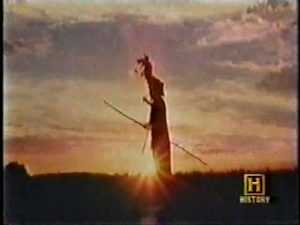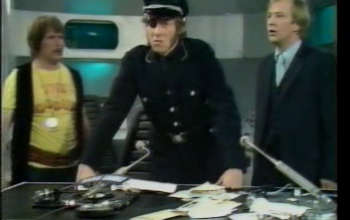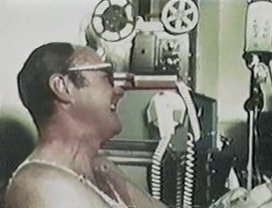In Search Of… S03E11 Indian Astronomers
We open on a bunch of Native Americans. Okay, didn’t see that coming. I thought ‘Indian Astronomy’ as in ‘Astronomy from India’. My bad. I don’t know if these are Native Americans or ‘Native Americans’ but they do a dance in some long grass. Nimoy tells us that they’re here to watch the stars, which is odd given that it’s broad daylight and it’s overcast. One of the ‘Native’ men is identified as a Priest of the Sun. A native woman goes down on her knees. The ‘priest’ produces a knife…
I am so looking this up.
And then we’re looking at Native American mounds, ad break.

We’re back. Reenactment time! A guy in animal skins is starting a fire with a flint. Nimoy tells us that we’re in Southern Illinois. The reenactor walks out of a hut, plants maize and hunts with a bow while the narration talks up the connection of the people to nature and the universe. Native American documentary boilerplate, basically.
Now we’re looking at the mounds. This is a little interesting, because it’s an underappreciated element of Native American history. These piles of earth used to be a city of 40 000 people. To prove this, we see a khaki-clad archaeologist Dr Wichery overseeing an excavation of the mounds that were once the city of Cahokia. The footage of an archaeological dig in progress is really quite interesting, though I wish the students didn’t wear 1970s jogging shorts. Ugh.
Dr Wichery and his team discovered hundreds of wooden posts, which once formed a vast circle. Nimoy and Dr Wichery both claim that the circle was used in a similar way to Stonehenge – that is, as a kind of calendar. In fact Cahokia is more accurately aligned than Stonehenge. Suck it, Celts.
Back to the Native (or ‘Native’?’) extras dancing in the grass. Nimoy talks about how the people of Cahokia used their astrological calendar to answer important questions. The reference for this whole bit is ‘anthropologists say’ which is pushing it. We know even less about the Mound Builder civilization than we do about the Aztecs. Nimoy talks up the power and importance of the Sun Priest. Definitely looking it up.
Back to the dig. Are you wearing jorts, dude? Oh, man. Anyway, there was evidence of human sacrifice at Cahokia and since apparently human sacrifice + Native Amerians = Aztecs, we’re off to the Aztec pyramids. Aztecs build buildings and did astronomy and sacrifice and… Now we’re in Maya country. They were good at geometry.
Nimoy says that it’s hard to see a connection between the Maya and the Cahokians. Yes and no? Probably not a lot of interaction between the cultures, but no reason there couldn’t be some. I guess. This must be a fairly factual episode. Usually even I – a non-expert – can usually tell when this show is talking absolute crap about archaeology but here I can’t. So they’re at least keeping on this side of plausible, probably?
Anyway, Dr Whichery has tentatively identified the unit of measurement in Cahokia and this is close to the unit of measure used by the Maya. Cahokian society seems to have begun around the same time that the Maya collapsed.
I’m going to look up the whole Maya/Cahokia thing at the end. For now, I’m just going to look at how this show constructs a plausible argument. Strangely? It’s very similar to the way it constructs a ludicrous argument.
We see the reenactors again. They seem to be dressed in Plains Indians sort of clothing, which I guess is because the costume hire people didn’t have Cahokian robes. Nimoy talks about the similarities in religion and astronomy between the Maya and Cahokians. Now Nimoy is sitting at the base of a rocky hill casting scorn on the idea that the Maya could have come so far and been so influential in the space of a century.
But! This scorn is just rhetorical. He’s about to suggest a ‘bridge’ between the Mayan cities of southern Mexico and the Cahokians of Illinois. This bridge – for the sake of simplicity, let’s call it “the land mass of North America” – took the Maya to the US South West where the Anasazi…
Oh, man. Right. The “Anasazi” is a name sometimes given to the ancestors of the modern Pueblo people. The Pueblo had a massive and impressive civilization in the South West which died out. For reasons that I don’t fully understand, this has become a part of UFO and pseudoarchaological lore.
Nimoy wonders about the towers of the Anasazi. We talk to an astronomer from the Smithsonian Institution, Dr Ray Williams, who thinks the towers were used for astronomical observations. So the Maya, the Anasazi and the Cahokians all used astronomy. Dr Williams is quite open about the fact that his idea is just a hypothesis, but we’re running with it.
Shot of a Mayan pyramid, which looks very different to the Anasazi tower, but Nimoy wonders if they’re connected. There are lots of interesting shots here of archaeological sites, but the argument is a little repetitive. Robert Hicks of the University of Arizona says that the alignments on the Pueblo site of Casa Grande is similar to Mayan sites.
The best re-enactment yet as a bunch of people in costumes cast their shadows on the Pueblo walls as Nimoy says that Hicks’ theory isn’t popular among anthropologists.
Back from the ad break, we’re looking at Charco Canyon, a truly impressive Pueblo site. Dr Williams is there to make a siting of the sun at the solstice. There is an alignment of light from one window against another window on the solstice.
Reenactors in the desert do a dodgy looking fire ceremony. Nimoy talks about the Pueblo building a vast city in the desert ‘almost overnight’. Their economy was based on the production and trade of turquoise. Possibly the Aztecs bought turquoise from the Pueblo, as it was sacred to Quetzalcoatl. The extremely intense anthropologist Jonathan Raymond of Illinois State University talks up how important turquoise was to the Aztecs.
Nimoy wonders if knowledge changed hands as well trade goods. Raymond argues that the Pueblo came under Aztec economic exploitation and Aztec religious influence. There’s yet another crappy re-enactment of an unusual burial in Pueblo country, accompanied by human sacrifice.
As often happens on this show, the argument has suddenly gone from plodding and circular to a break-neck bolt for the conclusion.
Nimoy claims that Dr Raymond has learned about Pueblo astronomy using a computer. This was probably impressive in 1978. Raymond – who has not only a safari suit but a magnificent 1970s ‘tache – Raymond claims that the Pueblo/Anasazi used similar stellar references as other native people of the American South West –
And at this point, my recording breaks down, a minute or two from the end. Huh. Well, there was no Anasazi/UFO connection in the part that I saw, so I’m going to be an optimist and assume that there was none coming.
So anyway, shorn of silly and culturally awkward reenactments, the argument of this episode is that ideas about astronomy circulated throughout North America along major trade routes. The key story is the one told between the lines – of a pre-Colombian North America that was a patchwork of sophisticated civilizations trading with one another. I don’t know how accurate this is, and the specific focus on astronomy may be idiosyncratically ’70s-y, but even so the whole episode makes me wish I knew more about North American archaeology.
And honestly, that’s a good thing. Often I watch this show and come away with the smug feeling of knowing better than the people who made it. It’s a rare episode of this show that makes me appreciate my ignorance and seek to learn more. And it’s a very rare episode that is more interesting to watch than it is to complain about.
Quotes
This one’s a bit short on weirdness.
Summing Up:
Interesting footage: 9/10, Actual expert interviewees: 9/10, Useful information: 8/10, Makes me think that if I was ever in New Mexico I’d rather see Chaco Canyon than throw pizza on Walter White’s roof: 8/10, Jorts: 9/10. Overall: 43/50. High Distinction.



